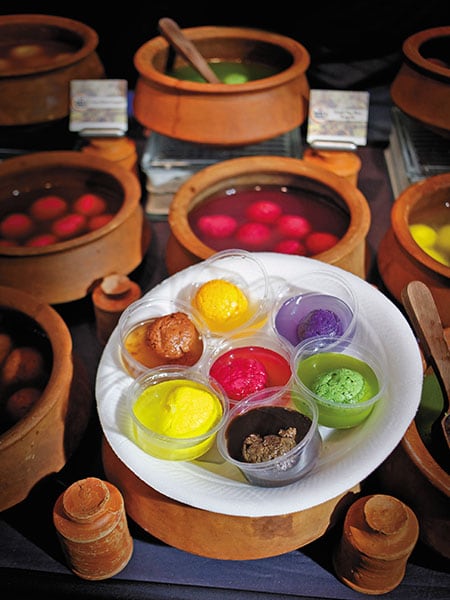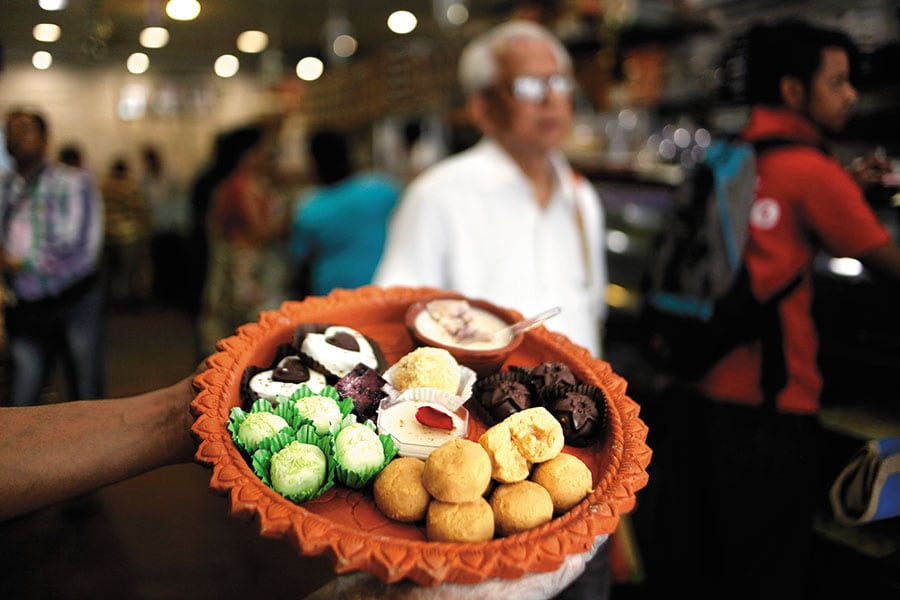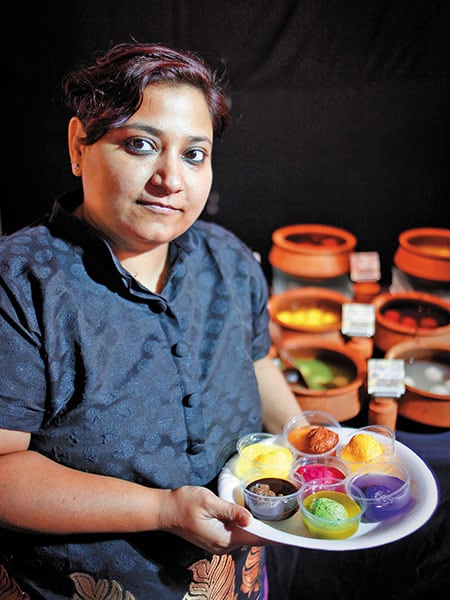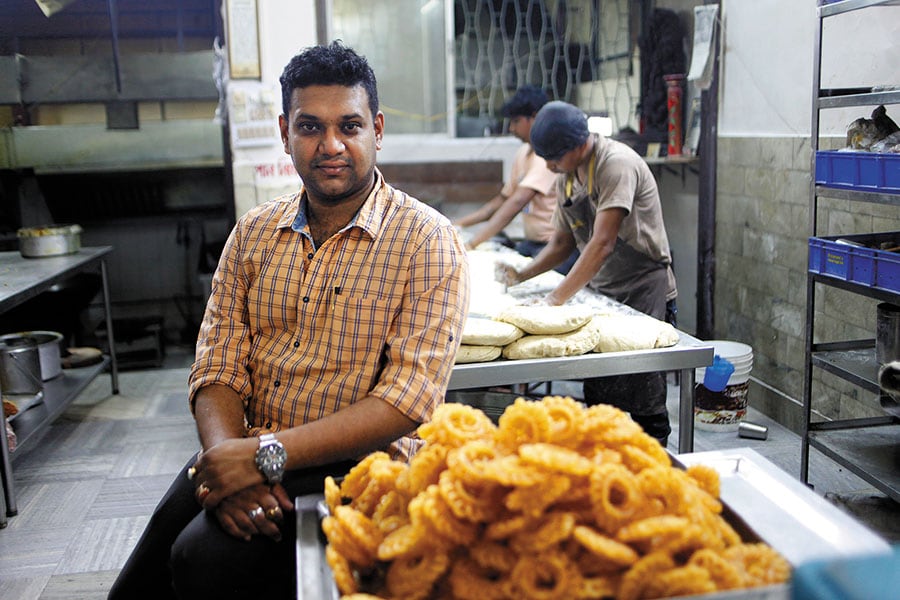Reinventing the rosogolla
Bengali sweetmakers are heralding a new wave of innovation with global flavours and favourites


 Rosogollas are now available in flavours ranging from green chilly and blueberry to the quirky karela and even vodka
Rosogollas are now available in flavours ranging from green chilly and blueberry to the quirky karela and even vodka
Image: Subrata Biswas for Forbes India
Of the many things that raised the proverbial storm in the morning cup of Darjeeling tea at a Kolkata home in the mid-1990s was the goings-on in the state’s first household: The governor’s. Of course there was that impassioned debate about the ‘historic blunder’ (the CPM’s refusal to let then-chief minister Jyoti Basu move on to national politics as prime minister), and the headline-grabbing act of Sourav Ganguly’s Test century at Lord’s on debut. But sharing equal mindspace at the breakfast table was the menu of the official Independence Day reception at the Raj Bhavan that, for a few years then, had been serving sweets from a local Marwari shop. For a community that believes it owns the veritable sweet tooth as well as arguably the largest number of sweet shops every kilometre, this was cause of much heartburn.
The Bengali hubris over its sweets legacy is not entirely misplaced. Long before the rest of the country took to curdling milk—deliberately spoiling a product of the sacred cow by adding an acid was considered a sin—Bengalis, swayed by Portuguese influence, warmed up to fresh cottage cheese (chhana). In her book Eating India: Exploring A Nation’s Cuisine, food historian Chitrita Banerji writes that while there is no documented evidence prior to the 18th century of chhana being used for sweets, “...once the Portuguese had settled around the Bay of Bengal and the Bengalis discovered that they were very fond of fresh cottage cheese—queijos frescos—some enterprising person must have welcomed the economic opportunity of making cheese.”
To a community that has historically embraced foreign influences in cooking—the egg sandesh, for instance, with a white outer coating and a yellow inner layer, was inspired by the British fondness for eggs—the inclusion of chhana in kitchens helped the sweet industry explode, says Pritha Sen, food anthropologist and writer. It gave the sweetmakers a key differentiator to stand out amidst shops ubiquitous across India that made their sweets with khoya, dalda, dals and even vegetables (consider morabba), but never chhana, which gave Bengali sweets its unique taste.  Bengali sweet shops are marrying tradition with innovation and selling stuff like chocolate sandesh with butterscotch filling
Bengali sweet shops are marrying tradition with innovation and selling stuff like chocolate sandesh with butterscotch filling
Image: Subrata Biswas for Forbes IndiaYet, despite the headstart over centuries, it was at the end of the 20th century that Bengali sweets ceded ground to what many Kolkata locals would derisively call the “non-Bengali” sweet shops. Its genre-defining rosogollas were covered with a crust of khoya, layered with cream and pista and sold as Nehru bhog its chamcham (a bolster-shaped family member of the rosogolla) was layered with various toppings and passed off as malai chamcham. And the Bengali, hitherto price-conscious and a stickler for tradition, fell for the novelty of the frills and wolfed them down for anything between ₹7 and ₹10 a piece, more than double of what the humble sandesh sold for.
Why couldn’t the Bengali sweet-makers outhink their competitors at this juncture? Perhaps the industrial torpor that Bengal was going through in the 1980s and the ’90s was to blame. In an era best defined by trade unionism and a restive Leftist rule, a number of industry bigwigs, including Brooke Bond India, Bata and Phillips India, left the state. “The political and economic factors at that time didn’t really lend themselves to innovative thinking. Besides, there were traditionalists in the industry who were refusing to budge. The fresh blood of the next generation hadn’t come in yet and dominant was the cholche-cholbe (what is going on will go on) attitude Bengal was infamous for,” says Sen.
Through this period of somnolence, the industry did rustle up a few innovations, like the aam doi (mango curd) or rosogolla flavoured with notun gur (a specialty jaggery from Bengal), but they were at too low a scale for any significant impact. However, from the mid-noughties onwards, a young and upwardly mobile demography, buoyed by the winds of a liberal economy, changed that. With incomes on the rise and exposure to global cultures through the rapid expansion of the World Wide Web, youngsters weren’t just picking up the odd twang and fashion trend, but also evolving palates, bridging the divide between mishti doi and mille-feuille.
“We’ve seen abroad how bakeries and patisseries have innovated. We thought, ‘why couldn’t our indigenous desserts evolve in a similar way?’” says Subhajit Ghosh, director of Banchharam’s, one of the youngest but fastest-growing sweet shops in Kolkata. “Innovation is nothing but a fusion of the traditional and the modern, of the Western and the Indian, and presenting it in a manner that makes it good to look and even better to taste.” 
Home chef Swati Saraf with natural-flavoured rosogollas
Image: Subrata Biswas for Forbes IndiaBanchharam’s mihidana (miniscule sweet boondis) tart, baked mihidana gulab jamun slice, sancake (a cake base topped with sandesh and garnished with cream made from doodh malai), and the chocolate mousse-sandesh (along with traditional favourites, of course) not only manage to make the twain meet, but are bringing back youngsters, its future customers, to the sweet shop, giving the business a fillip like never before.
In 10 years from 2007, the store (set up by Ghosh’s father in 1974) has gone from two to 20 branches in Kolkata, launched in Bengaluru and is coming up soon in Mumbai, Bhubaneswar and Siliguri. Through its furious expansion—it has raked in about ₹23 crore in FY17—and its hub-and-spoke model (it functions from a central kitchen and sells from multiple outlets), Banchharam’s has outdone many times over the traditional sweet shops that typically operated from a single outlet an attached kitchen.
What helped bring in a fuss-free systemic change in the past decade is the Bengali sweet industry’s familiarity with innovation over centuries. The rosogolla, for instance, wasn’t something the Bengalis had known forever. It came out of an experiment by Nobin Chandra Das in 1868 , says Dhiman Das, the director of KC Das Pvt Ltd, the famous rosogolla makers. Nobin’s son Krishna Chandra Das (after whom the company is named), along with his youngest son Sarada Charan, a research assistant to scientist CV Raman, mastered the art of increasing its shelf life and packing it in a can in 1930, enabling it to be transported across the country.
Food writer Sen recalls the story of Surjya Modak of Chandernagore, a French settlement near Kolkata, who was tasked by a customer in 1818 to make a sweet that would surprise his son-in-law. Modak created the jolbhora, a sweet shaped like a palm kernel (taal shaansh in Bengali, tadgola in Hindi) with a filling of rose syrup that would ooze out once the son-in-law bit into it. The modern sweet shops have built on such a culture of innovation, but at a pace that would leave the food gods gasping for breath. Over the past five to seven years, Nalinchandra Das, sweetmakers for nearly 200 years, is producing 20 versions of the jolbhora, with fillings including strawberry, kiwi, black currant, pineapple, litchi and orange.  Sudip Mullick faced severe criticism when he started selling baked rosogollas
Sudip Mullick faced severe criticism when he started selling baked rosogollas
Image: Subrata Biswas for Forbes IndiaFurther, in keeping with its innovation philosophy of introducing a surprise element, says Tapan Das, managing partner and the sixth generation to come into the business at Nalinchandra Das, the shop has come up with offerings that “look something and taste something else”: The chocolate sandesh with butterscotch filling, mango sandesh with strawberry filling, the desi black forest (a soft chhana mass coated with molten chocolate), and fusion (soft chocolate sandesh covered with a layer of white chocolate). “We had to up our innovative thinking in the last few years because the market was way too competitive. Earlier, there were eight to 10 heritage sweet shops, and local shops catered to only a local clientele. Now, everyone is expanding beyond their area with the help of online delivery partners. We had to think different. That has helped our business grow 10 to 15 times in the last 10 years,” says Das.
What has helped assimilate the East and the West is that innovation in the Bengali sweet industry has been a two-way street. Not only are foreign tastes such as kiwi and blackberry and cooking processes like baking and glazing being used to embellish traditional tastes, a quintessential Bengali jaggery like notun gur is making peace with flavouring a souffle or a madeleine. “I had to face a lot of criticism when I started baked rosogolla. I was told I would char what occupied a pride of place in Bengal. Now, the baked rosogolla is one of the most popular items in our shops,” says Sudip Mullick, the director of Balaram Mullick and Radharaman Mullick, who, in 2003, took over the reins of the 132-year-old shop. “People tend to think innovation kills tradition. They forget that tradition at one point was nothing but innovation.”
Is the younger generation lapping up the likes of the chocolate butterscotch sandesh and the litchi paayesh (where a gulab jamun slice is inserted into the flesh of the fruit to mirror the seed)? Riddhiman Roy, a 17-year-old with a sweet ‘fang’, is. “I have grown up with innovations like the chocolate sandesh or the ice cream sandesh. But every time I have the blueberry- or strawberry-flavoured sweets, or specialities like the daab sandesh mousse [tender coconut mousse] I am thrown,” he says. So is a staunch traditionalist octogenarian who is sold on the mango souffle of Balaram Mullick and Radharaman Mullick. “The gentleman’s son told me that he, who wouldn’t touch the new-age sweets, now queues up to buy the souffle,” says Mullick.
undefinedBengali sweetmakers believe that the North Indian sweet bastion has been conquered[/bq]
Innovation also comes as a trump card to attract the young, health-conscious clientele that has shunned quantity for quality with sandesh-eating competitions becoming passé, the youth of today would rather pick at a few unique pieces. With an eye on them, Swati Saraf, a homechef from Kolkata, has taken the plebeian rosogolla and added a variety of natural flavours that range from green chilly, watermelon and blueberry to panipuri, bubblegum (a mix of pomegranate and mint) and Maggi. “Once, my mother was going to give away a box of rosogollas because no one would have them. I was aghast, because they came from a renowned shop, and decided to do something different with them,” says Saraf, who launched in April 2016 with 50 flavours and now serves up to 270, including the quirky karela or the vodka rosogollas.
The sweetmakers are confident that the tide has turned. That, for now, the North Indian sweet bastion has been conquered. “They’ll never be adept at the use of chhana like us. They don’t know tricks like how the butterscotch sweets need coarser chhana, while the jolbhoras far softer,” says Das. But they don’t want to rest smug either. Das, Mullick and their ilk have taken innovation beyond the core product and made it a recurrent theme in store formats—large, airconditioned spaces with seating arrangements that make them a place to hang out—as well as state-of-the-art production facilities.
For traditional sweet shops with their dingy kitchen, health wasn’t as high on the priority list as taste. The new generation of sweetmakers is bringing in a change here as well. Mullick’s sweets are now prepared with pharma-grade, sulphur-free sugar and he’s started a segment where flavours (from extracts, oils, oleoresins, pulps and juices), and colours (green from chlorophyll, red from beetroot etc) are 100 percent natural. Nalinchandra Das makes all chhana in-house for quality control, and KC Das is adding multi-vitamins, fibre and calcium to the canned rosogolla to raise its nutritional value.
To match up to global standards in infrastructure, Mullick has imported machines from Japan, Denmark, Italy and other countries to ramp up production and make 8,000 pieces of sandesh in an hour compared to just 1,000 made by 10 people earlier. Banchharam’s is setting up a factory in Sankrail, in the Howrah district neighbouring Kolkata, where sweets, especially those with a short shelf-life, will be packaged for transport across India and exported. KC Das has a research and development centre in Bengaluru where biologists are working on innovations not just in flavours but also in the composition of sweets.
“We now have a competition for chocolate sweets organised by a top multinational. It is teaming up with sweet shops to increase penetration in Bengal. For the sweet shops too, that has brought in a competitive edge. It has given them assurance that now one can grow business even with a sweet shop.
This hope was lost for quite some time,” says Mullick.
First Published: Apr 28, 2018, 08:26
Subscribe Now